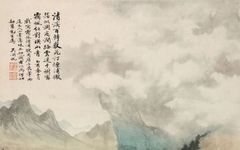
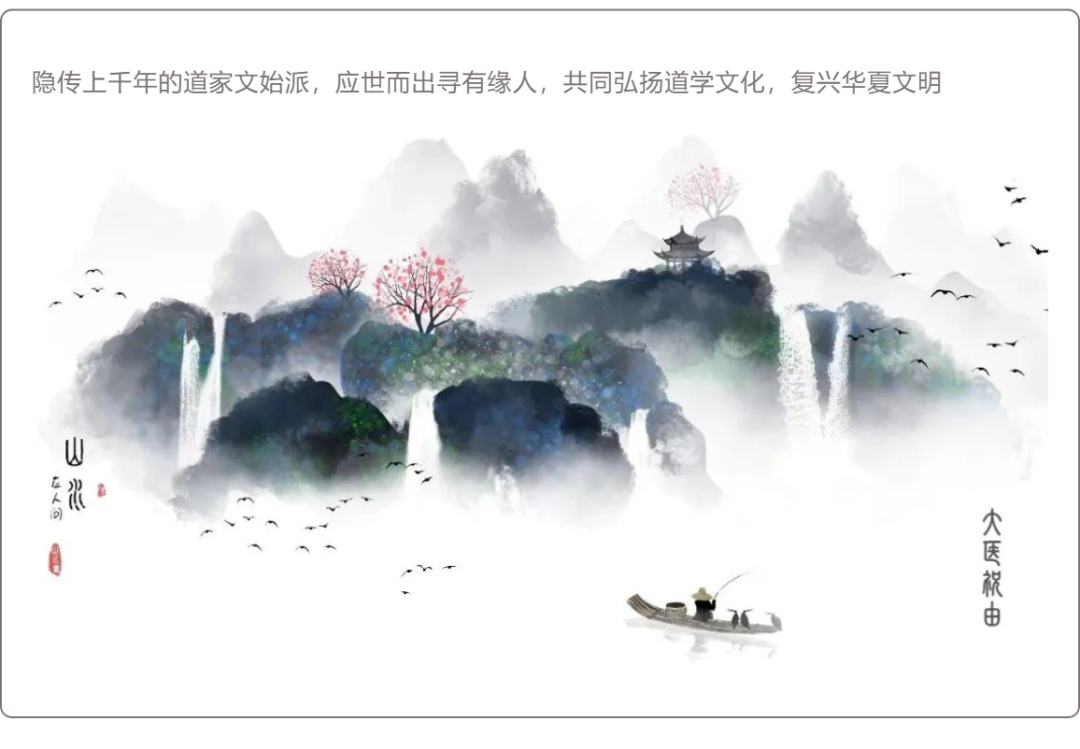
How to Regulate the Five Organs and Six Bowels Using the Six-Character Formula?
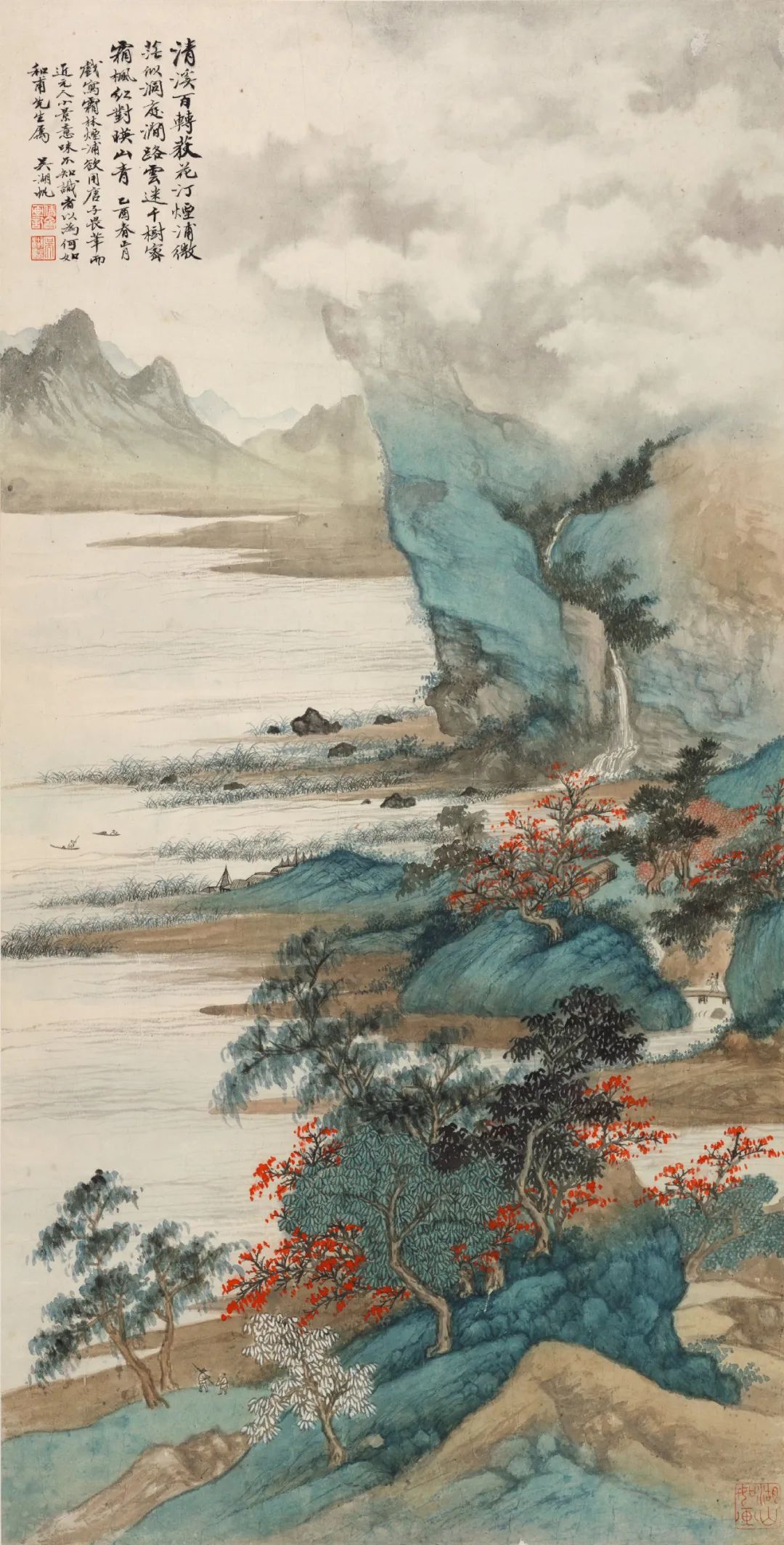
The Six-Character Formula, also known as the Six-Character Health Preservation Method, is an ancient health practice that has been passed down in China, serving as a method of breath regulation.Its main feature is to enhance the internal organ functions of the body through guided breathing, fully stimulating and mobilizing the potential abilities of the organs to resist disease attacks and prevent premature aging as one grows older. Many historical texts discuss this, including the “Lüshi Chunqiu” from the Qin and Han dynasties, which mentions using guided breathing to treat diseases.In the “Zhuangzi: Ke Yi” chapter, it states: “Blowing and breathing, expelling the old and inhaling the new, like a bear stretching and a bird soaring, is for longevity.”
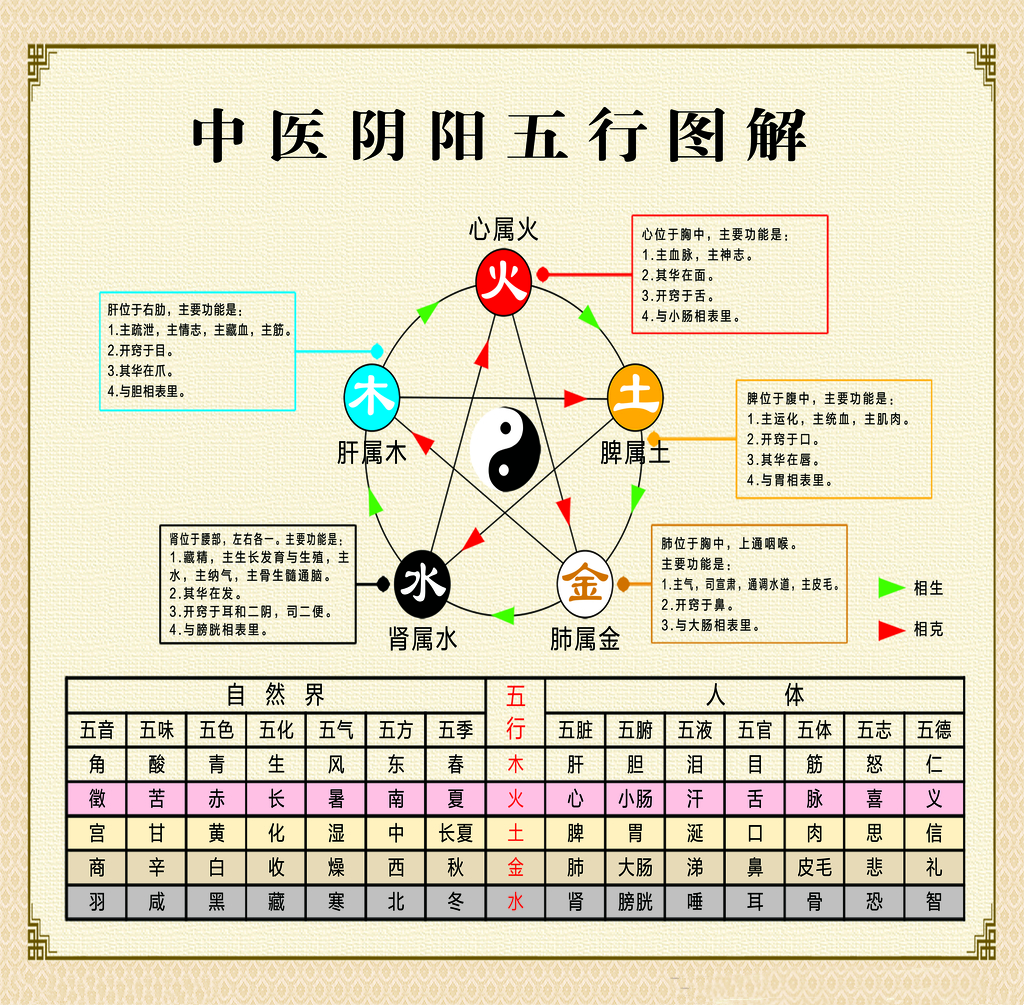
1. The Five Elements, Five Organs and Six Bowels, and the Six-Character Formula.1. The Six Bowels: In addition to the gallbladder, small intestine, stomach, large intestine, and bladder listed above, there is also the San Jiao (Triple Burner). The Six Bowels is a collective term for these six internal organs.2. The Meaning of San Jiao: The area above the diaphragm, including the head, chest, upper limbs, and heart-lung, is called the Upper Jiao. The area below the diaphragm and above the navel, including the liver-gallbladder and spleen-stomach, is called the Middle Jiao. The area below the navel and related organs, such as the small intestine, large intestine, kidneys, and bladder, is called the Lower Jiao.3. The Physiological Functions of San Jiao: One is to facilitate the flow of Yuan Qi (Original Qi), and the other is to regulate the movement of water and fluids.4. The Six-Character Formula’s techniques, in addition to the corresponding Five Elements and Five Organs of “Xu, He, Hu, Xu, Chui,” also includes the “Xi” character technique. This “Xi” is used to regulate the San Jiao.Song Verse:
Spring Xu brightens the eyes, summer He calms the heart, autumn Xu settles the lungs, winter Chui nourishes the kidneys.
Throughout the four seasons, always Hu to transform food in the spleen, San Jiao Xi expels heat that is hard to stop.
Hair should be combed regularly, Qi should be gathered, teeth should be tapped, and saliva should be swallowed.
To avoid death, cultivate Kunlun, rub your hands together and always be present.
Another Song Verse:Spring Xu brightens the eyes, wood supports the liver, summer He calms the heart, fire is relaxed in summer,Autumn Xu settles the lungs, kidney Chui must be stable in the Lower Jiao,Xi regulates the San Jiao to eliminate vexation and heat, throughout the four seasons, always Hu to transform meals,Do not make sounds that can be heard, only then will you know the efficacy surpasses elixirs.
1. Xu (read as xu) character technique calms liver Qi. The Xu character corresponds to the liver and spring; during spring, silently reading ‘Xu’ can help the liver wood to disperse, making the eyes bright;
2. He (read as he) character technique nourishes heart Qi. The He character corresponds to the heart and summer; during summer, silently reading ‘He’ can help the heart fire to be stored, keeping the heart calm;
3. Hu (read as hu) character technique cultivates spleen Qi. The Hu character corresponds to the spleen and all seasons; during all seasons, silently reading ‘Hu’ can enhance the spleen and stomach’s transformation and transportation functions, ensuring normal digestion and absorption;
4. Si (read as si) (also read as xia) character technique nourishes lung Qi. The Si character corresponds to the lungs and autumn; during autumn, silently reading ‘Si’ can help the lung Qi to be moist and not harmed by autumn dryness;
5. Chui (read as chui) character technique nourishes kidney Qi. The Chui character corresponds to the kidneys and winter; during winter, silently reading ‘Chui’ can help the kidney Yang (the fire in the kidneys, corresponding to the Kan trigram in the Eight Trigrams) to be stored, ensuring kidney Qi is stable;
6. Xi (read as xi)
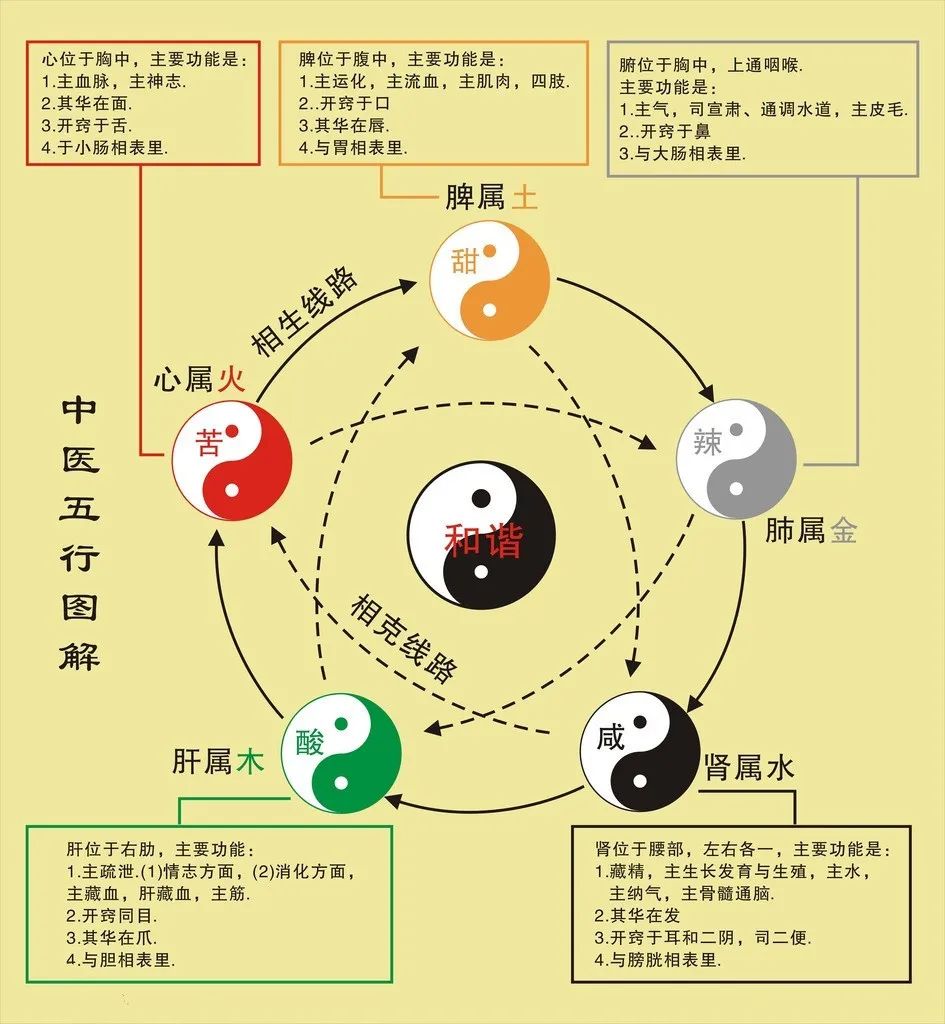 2. The Generation and Overcoming of the Five Elements. The Five Element theory in Traditional Chinese Medicine posits that all things in the world are generated through the movement and transformation of the five basic substances: wood, fire, earth, metal, and water. There exists a relationship of mutual generation and mutual restraint among these five substances, maintaining a dynamic balance through continuous cycles of generation and overcoming.1. Mutual Generation: The order of mutual generation among the Five Elements is: wood generates fire, fire generates earth, earth generates metal, metal generates water, and water generates wood. The mutual generation relationship can also be referred to as a mother-child relationship, such as wood generating fire, meaning wood is the mother of fire, and fire is the child of wood.2. Mutual Overcoming: The order of mutual overcoming among the Five Elements is: wood overcomes earth, earth overcomes water, water overcomes fire, fire overcomes metal, and metal overcomes wood.3. Mutual Generation and Overcoming are Inseparable: Without mutual generation, things cannot occur or grow; without mutual overcoming, things cannot be restrained, and normal coordinated relationships cannot be maintained. Only by maintaining a normal dynamic balance of mutual generation and overcoming can things occur and develop normally.4. Mutual Promotion or Mutual Insult (Pathological): Excessive or insufficient overcoming among the Five Elements can disrupt the normal generation and overcoming relationships, leading to mutual promotion or mutual insult situations. Mutual promotion occurs when one element excessively overcomes another; for example, if wood is overly vigorous (and metal cannot normally restrain wood, leading to wood’s excess), wood will excessively overcome earth, making earth weak, which is wood promoting earth. Mutual insult occurs when one element itself is too strong, preventing the element that overcomes it from restraining it, thus being restrained by it, hence called counter-overcoming or counter-insult. For example, in the case of wood promoting earth, wood counter-insults metal. Normally, water overcomes fire, but when water is too scarce or fire is too strong, water cannot overcome fire and instead gets dried up by fire, which is fire counter-overcoming or counter-insulting water. Mutual promotion or mutual insult disrupts the normal dynamic balance of mutual generation and overcoming.
2. The Generation and Overcoming of the Five Elements. The Five Element theory in Traditional Chinese Medicine posits that all things in the world are generated through the movement and transformation of the five basic substances: wood, fire, earth, metal, and water. There exists a relationship of mutual generation and mutual restraint among these five substances, maintaining a dynamic balance through continuous cycles of generation and overcoming.1. Mutual Generation: The order of mutual generation among the Five Elements is: wood generates fire, fire generates earth, earth generates metal, metal generates water, and water generates wood. The mutual generation relationship can also be referred to as a mother-child relationship, such as wood generating fire, meaning wood is the mother of fire, and fire is the child of wood.2. Mutual Overcoming: The order of mutual overcoming among the Five Elements is: wood overcomes earth, earth overcomes water, water overcomes fire, fire overcomes metal, and metal overcomes wood.3. Mutual Generation and Overcoming are Inseparable: Without mutual generation, things cannot occur or grow; without mutual overcoming, things cannot be restrained, and normal coordinated relationships cannot be maintained. Only by maintaining a normal dynamic balance of mutual generation and overcoming can things occur and develop normally.4. Mutual Promotion or Mutual Insult (Pathological): Excessive or insufficient overcoming among the Five Elements can disrupt the normal generation and overcoming relationships, leading to mutual promotion or mutual insult situations. Mutual promotion occurs when one element excessively overcomes another; for example, if wood is overly vigorous (and metal cannot normally restrain wood, leading to wood’s excess), wood will excessively overcome earth, making earth weak, which is wood promoting earth. Mutual insult occurs when one element itself is too strong, preventing the element that overcomes it from restraining it, thus being restrained by it, hence called counter-overcoming or counter-insult. For example, in the case of wood promoting earth, wood counter-insults metal. Normally, water overcomes fire, but when water is too scarce or fire is too strong, water cannot overcome fire and instead gets dried up by fire, which is fire counter-overcoming or counter-insulting water. Mutual promotion or mutual insult disrupts the normal dynamic balance of mutual generation and overcoming.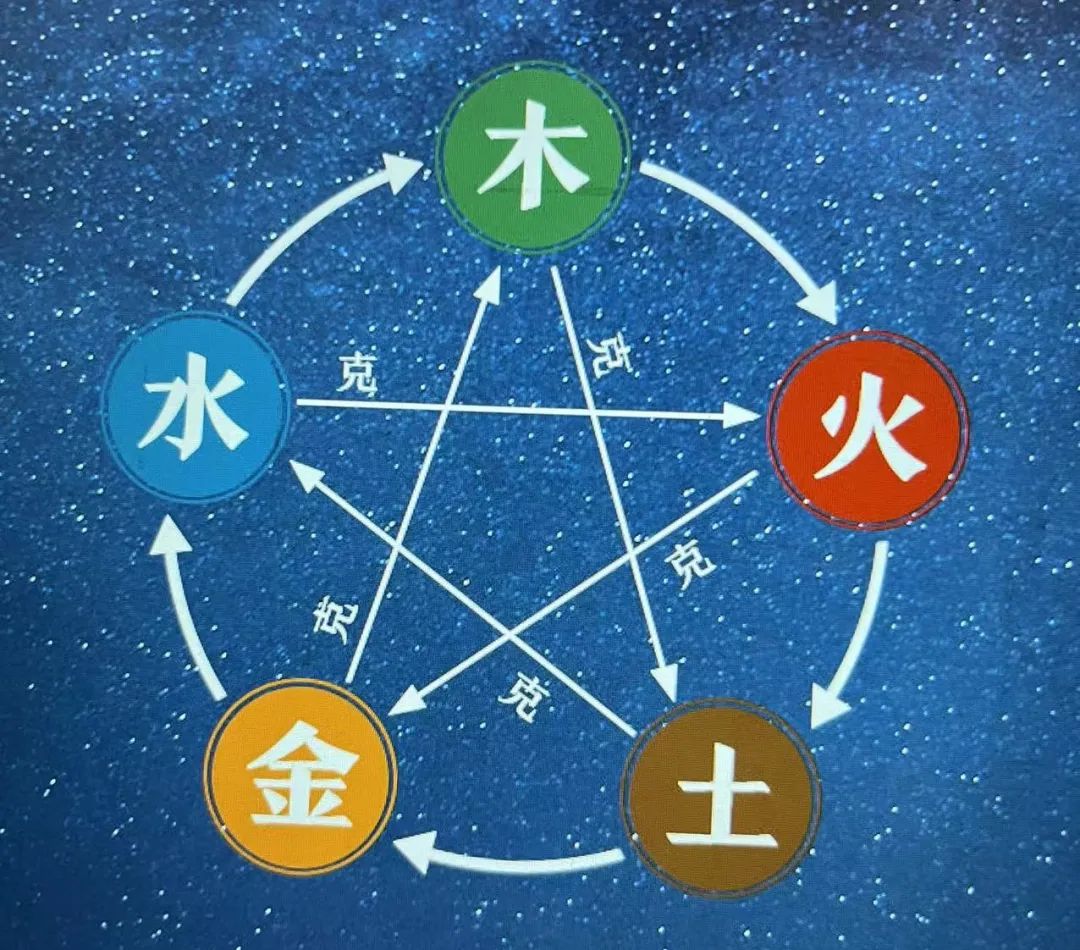 3. The Relationship of Generation and Overcoming between the Five Organs and Six Bowels and the Five Elements.Mutual Generation: The liver (wood) stores blood to assist the heart (fire), the heat of the heart (fire) warms the spleen (earth), the spleen (earth) transforms and generates the essence of food to nourish the lungs (metal), and the lungs (metal) clear and descend to assist the kidneys (water), while the essence of the kidneys (water) nourishes the liver (wood), illustrating the mutual generation relationship among the five organs.Mutual Overcoming: From the perspective of mutual restraint among the five organs, the clear and descending lung Qi can suppress the rising liver Yang, which is metal overcoming wood; the smooth liver Qi can relieve the stagnation of the spleen (earth), which is wood overcoming earth; the transformation of the spleen can prevent the flooding of kidney (water), which is earth overcoming water; the nourishment of kidney (water) can prevent the excessive heat of the heart (fire), which is water overcoming fire; and the heat of the heart (fire) can restrain the excessive clearing of lung (metal), which is fire overcoming metal.The Mother-Child Relationship and the Deficiency-Excess Relationship of the Five Organs:1. Mother Disease Affects Child: For example, if the mother organ (liver) is diseased first, it then affects the child organ (heart); the method is to first tonify the mother (liver). If the child is diseased and then affects the mother: if the child organ (liver) is diseased first, it then affects the mother organ (kidney), this situation is generally more severe, and it is not a normal mutual generation (mother affecting child) relationship. The method is to first tonify the “child” (if the mother organ is severely diseased, then tonify the mother and drain the child).2. Deficiency-Excess Relationship: Deficiency should tonify its mother, and excess should drain its child. For example, if the kidney (water) is deficient, it should tonify the lung (metal); if liver cirrhosis is an excess condition of the liver (wood), it should drain its child, the heart (fire).3. Mutual Promotion or Mutual Insult of the Five Organs: For example, liver disease can affect the spleen, causing spleen deficiency, which is wood promoting earth; while spleen disease can affect the liver, which is earth insulting wood; and the pathological influence between the liver and spleen can be wood stagnation and earth deficiency or earth congestion and wood stagnation. Liver disease can also affect the lungs, which is wood insulting metal.
3. The Relationship of Generation and Overcoming between the Five Organs and Six Bowels and the Five Elements.Mutual Generation: The liver (wood) stores blood to assist the heart (fire), the heat of the heart (fire) warms the spleen (earth), the spleen (earth) transforms and generates the essence of food to nourish the lungs (metal), and the lungs (metal) clear and descend to assist the kidneys (water), while the essence of the kidneys (water) nourishes the liver (wood), illustrating the mutual generation relationship among the five organs.Mutual Overcoming: From the perspective of mutual restraint among the five organs, the clear and descending lung Qi can suppress the rising liver Yang, which is metal overcoming wood; the smooth liver Qi can relieve the stagnation of the spleen (earth), which is wood overcoming earth; the transformation of the spleen can prevent the flooding of kidney (water), which is earth overcoming water; the nourishment of kidney (water) can prevent the excessive heat of the heart (fire), which is water overcoming fire; and the heat of the heart (fire) can restrain the excessive clearing of lung (metal), which is fire overcoming metal.The Mother-Child Relationship and the Deficiency-Excess Relationship of the Five Organs:1. Mother Disease Affects Child: For example, if the mother organ (liver) is diseased first, it then affects the child organ (heart); the method is to first tonify the mother (liver). If the child is diseased and then affects the mother: if the child organ (liver) is diseased first, it then affects the mother organ (kidney), this situation is generally more severe, and it is not a normal mutual generation (mother affecting child) relationship. The method is to first tonify the “child” (if the mother organ is severely diseased, then tonify the mother and drain the child).2. Deficiency-Excess Relationship: Deficiency should tonify its mother, and excess should drain its child. For example, if the kidney (water) is deficient, it should tonify the lung (metal); if liver cirrhosis is an excess condition of the liver (wood), it should drain its child, the heart (fire).3. Mutual Promotion or Mutual Insult of the Five Organs: For example, liver disease can affect the spleen, causing spleen deficiency, which is wood promoting earth; while spleen disease can affect the liver, which is earth insulting wood; and the pathological influence between the liver and spleen can be wood stagnation and earth deficiency or earth congestion and wood stagnation. Liver disease can also affect the lungs, which is wood insulting metal.
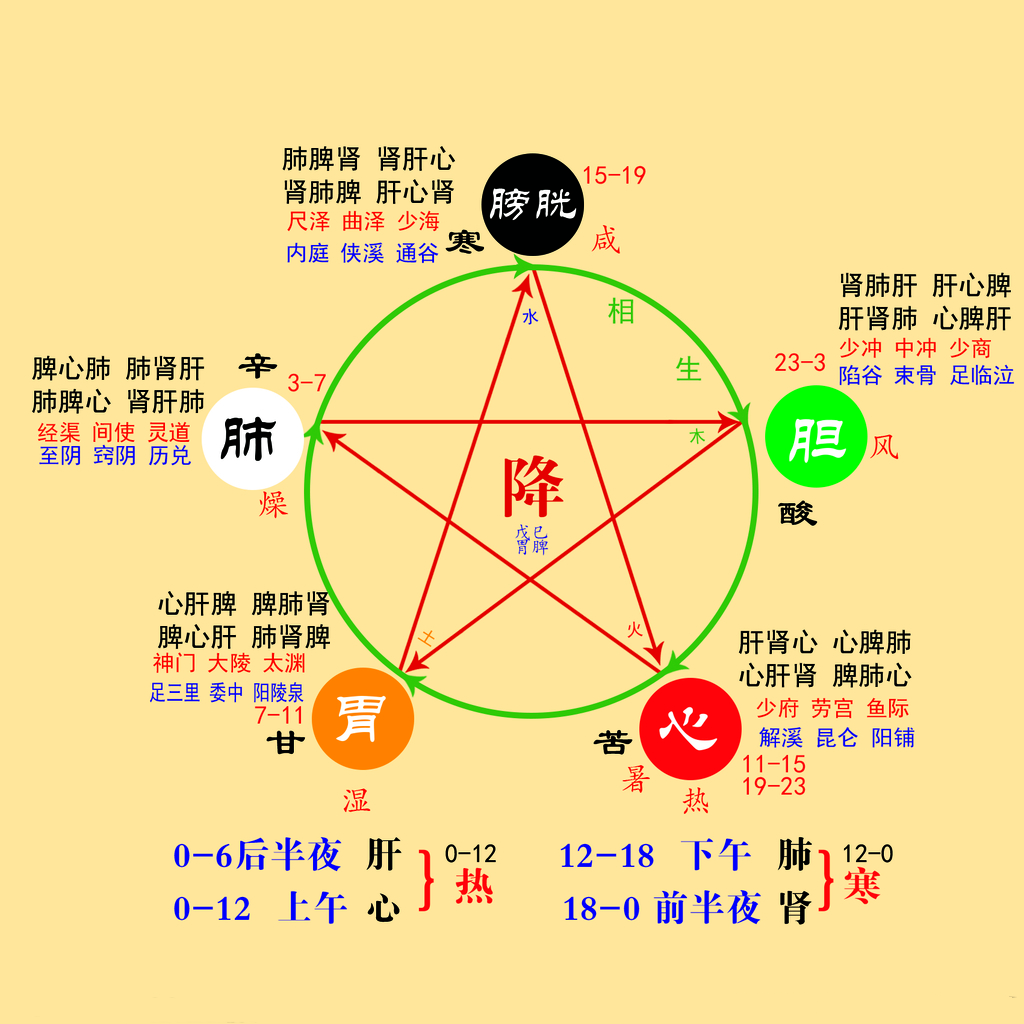
4. Referencing the Five Elements, Five Organs, and the Six-Character Formula for Balancing and Preventing Diseases of the Organs.1. The Basis of the Six-Character Sound for Treating Diseases of the Five Organs and Six Bowels: The earliest existing literature on the Six-Character Formula can be found in the “Record of Nurturing Life and Extending Life” by Tao Hongjing from the Liang dynasty during the Southern and Northern Dynasties. The six character sounds can treat corresponding diseases of the “liver, heart, spleen, lungs, kidneys, and San Jiao”; this has been recognized by physicians, Daoists, and health practitioners throughout history to the present day.“In practicing the Six-Character Formula, if the goal is to treat diseases, one should practice in the order of overcoming among the Five Elements: He—Si—Xu—Hu—Chui—Xi. If the goal is long-term health preservation, one should practice in the order of generation among the Five Elements: Xu—He—Hu—Si—Chui—Xi.” This also indicates that as long as one practices the sounds of “Si, He, Hu, Xu, Chui, Xi“, one can achieve the yin-yang balance in a certain organ (certain organ) within the corresponding Five Elements (Five Organs). 2. Using Specific Order to Read the Six-Character Sounds to Prevent and Treat Specific Organ Diseases:Principle: For a specific diseased organ, read the sounds of the five organs in the order of mutual generation (including the organ itself and its mother and child organs) and mutual overcoming (including the organ itself and the organs that promote or insult it), and finally read the “Xi” character to smooth the Qi of the San Jiao, which can specifically treat the disease of that organ. For a specific “spleen earth Hu” disease, according to the Five Elements, this disrupts the generation and overcoming relationship centered on “earth”; the solution is:01. In the order of mutual generation among the Five Elements, first tonify the mother “heart fire Ke”, then drain the child “lung metal Si (read as xie)”; the sound treatment method: First read “Ke, Hu”, then read “Si, Hu”.02. In the order of mutual overcoming and promotion, first read the one that overcomes me (spleen earth Hu) which is “liver wood Xu”, then read the one that I (spleen earth Hu) overcome which is “kidney water Chui”; the sound treatment method: first read “Xu, Hu”, then read “Chui, Hu”.03. By reading the above A and B five character sounds, one can achieve balance among the four directions of “heart fire, lung metal, liver wood, kidney water” centered on “spleen earth Hu” (the principle is that reading which character can achieve yin-yang balance in the corresponding organ), thus “spleen earth” naturally achieves yin-yang balance.04. Finally, read “Xi” to expel the pathogenic Qi of the “spleen earth” from the “Yongquan point” out of the body by regulating the San Jiao. This way, the diseases of the spleen and stomach are treated.Using Specific Order of Six-Character Sounds for Treating Different Organ Diseases:01. Prevention and Treatment of Liver, Gallbladder, and Related Diseases: First read in the order of “Xu—Ke—Hu—Si—Chui—Xi” for one to two times, then read in the specific order of “Chui—Xu—Ke—Xu—Si—Xu—Hu—Xu—Xi” for six times, and finally read in the order of “Xu—Ke—Hu—Si—Chui—Xi” for one to two times.02. Prevention and Treatment of Heart, Small Intestine, and Related Diseases: First read in the order of “Xu—Ke—Hu—Si—Chui—Xi” for one to two times, then read in the specific order of “Xu—Ke—Hu—Ke—Chui—Ke—Si—Ke—Xi” for six times, and finally read in the order of “Xu—Ke—Hu—Si—Chui—Xi” for one to two times.03. Prevention and Treatment of Spleen, Stomach, and Related Diseases: First read in the order of “Xu—Ke—Hu—Si—Chui—Xi” for one to two times, then read in the specific order of “Ke—Hu—Si—Hu—Xu—Hu—Chui—Hu—Xi” for six times, and finally read in the order of “Xu—Ke—Hu—Si—Chui—Xi” for one to two times.04. Prevention and Treatment of Lung, Large Intestine, and Related Diseases: First read in the order of “Xu—Ke—Hu—Si—Chui—Xi” for one to two times, then read in the specific order of “Hu—Si—Chui—Si—Ke—Si—Xu—Si—Xi” for six times, and finally read in the order of “Xu—Ke—Hu—Si—Chui—Xi” for one to two times.05. Prevention and Treatment of Kidney, Bladder, and Related Diseases: First read in the order of “Xu—Ke—Hu—Si—Chui—Xi” for one to two times, then read in the specific order of “Si—Chui—Xu—Chui—Hu—Chui—Ke—Chui—Xi” for six times, and finally read in the order of “Xu—Ke—Hu—Si—Chui—Xi” for one to two times. In summary, practicing the Six-Character Formula not only prevents and treats specific organ diseases but also has excellent effects on the overall health of the five organs and six bowels. The related movements of the Six-Character Formula can yield quicker results, and practicing without movements (standing, sitting, or lying down) can also achieve good effects as long as one persists in practice. Regardless of how one practices, it is essential to maintain abdominal breathing: when reading the characters, only produce sound without voice. One should expel the turbid Qi (pathogenic Qi) of the related organs through the mouth (with the intention of contracting the abdomen and lifting the anus), and then slowly inhale sufficient clear Qi (oxygen) through the nose, allowing the Qi to fill the lower abdomen naturally. Do not rush or hold your breath; if breath-holding occurs, use a few natural breaths as a buffer.When reading the characters, it is best to think of the related organs: Xu—think of the liver under the right rib, the reading is best done with wide-open eyes. He—think of the heart in the left chest. Hu—think of the Zhongwan point, which is four fingerbreadths above the navel. Si—think of both lungs. Chui—think of both lower back points. Xi—think of the highest point on the head, the Baihui point, with a stream of clear Qi carrying the pathogenic Qi of the related organs through the chest, abdomen, and legs, out through the “Yongquan point” at the feet. Blood pressure and headaches belong to the “liver and gallbladder”. Cardiovascular issues belong to the “heart and small intestine”. Digestive system diseases and diabetes belong to the “spleen and stomach”. Respiratory system diseases belong to the “lungs and large intestine”. Urinary system diseases belong to the “kidneys and bladder”.Consistent practice of two or more times daily can comprehensively nurture the five organs and six bowels.



Disclaimer: The images and text are sourced from the internet and do not necessarily represent the views of this account; they are shared for informational purposes only, and copyright belongs to the original author. If there are any copyright issues, please contact us for resolution.
If you like the article, please clickto view,follow our public account, and light up the little star⭐ to receive notifications promptly.
Mr. Taiyi. Xihuang Lecture Hall
1. Mr. Taiyi Interprets the True Essence of Daoism
2. The Past and Present of the Four Pure Lands in Daoism
3. Understanding Quantum Mechanics through Daoist Symbolism
4. Entering Zhuangzi’s World of Nanhua
5. Mr. Taiyi Correctly Interprets the “Classic of Purity and Stillness”
6. Mr. Taiyi’s Wonderful Interpretation of the “Yellow Emperor’s Yin Symbol Classic”
7. Why are there Many Discrepancies in the Commentaries on the “Dao De Jing”?
8. The Fifteen Disciplines of Daoist Transmission



Zhuyou is a technique that uses various linguistic tools to trigger the core functions of the brain’s pineal gland area.
At a lower level, Zhuyou is hypnosis; hypnosis still operates under the state of consciousness where thoughts and distinctions are present, either consciously or unconsciously.At a medium level, it is a technique that allows the original spirit to manifest and take charge, characterized by the practitioner being free of thoughts and possessing spiritual awareness; its main application is in Traditional Chinese Medicine Psychology.
At the highest level of Zhuyou, it is self-Zhuyou. Active cultivation techniques can be considered a method of achieving self-Zhuyou through practice. Self-Zhuyou is the intrinsic common core of all life science practice techniques.
Zhuyou is not mysterious; it is an essential component of traditional Chinese medicine and a psychological healing technique within TCM. Traditional Chinese Medicine believes that emotions are the root of diseases. Negative emotions lead to erroneous behavioral habits, resulting in physical illnesses. How to adjust emotions? Those with wisdom can certainly be taught life sciences for self-cultivation, but how can those without wisdom and unwilling to self-cultivate handle it? Zhuyou is the solution for them.
In short, Zhuyou is a technique that allows passive cultivation. The Daoist Great Accomplishment Pure Land Method is a representative of Zhuyou-type techniques.
Since ancient times, Zhuyou has occupied half of the field of traditional Chinese medicine. Whether in internal or external treatment methods, without Zhuyou, it is difficult to exert the effects of the therapy itself. Only when the true transmission of Zhuyou flourishes can traditional Chinese medicine truly thrive.





